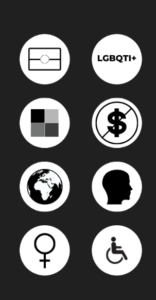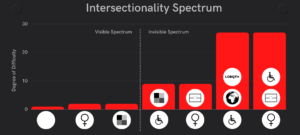
Intersectionality is belonging to more than one marginalised group. It means that you have more “areas” that can open you up for attack. Understanding the range of areas and the effects is key to being able to help.
Intersectionality was originally coined by Kimberlé Williams Crenshaw in 1991 in her publication “Mapping the Margins: Intersectionality, Identity Politics, and Violence against Women of Color”.
The way we explain intersectionality is as through the Intersectionality Spectrum (see below), where the more marginalised groups you belong to, the higher the degree of difficulty.
